The MP-18,I was most likely the first true submachine gun to see combat use, issued in the final months of World War One to German Sturmtruppen. These guns were originally fitted with 32-round drum magazines form the Artillery Luger, but they were almost all quickly changed to standard System Schmeisser box magazines shortly after the war ended. This is a rare example of one still in its original configuration, as brought home by a US soldier as a war trophy.
The MP-18,I set the standard for basically all future SMGs. It has remarkably gentle to shoot, with a low rate of fire and nice big sights. The drum does throw the balance substantially off to the left side, but it has few other serious problems.




In trench conditions (especially during a raid), the offset balance would be the last bothersome thing on your mind compared to getting shot or stabbed while changing magazines. I am just guessing, though.
Two questions: Can the drum be operated w/o the sleeve by carefully inserting it up to the magazine catch (obviously the sleeve acts as a mag stop); has anyone fired this using ordinary Luger mags?
Regarding the bringbacks — I’d imagine that people had a much more “functional” attitude toward guns back then. A rifle was for hunting. A pistol was for self-defense. Even if a lot of doughboys thought an SMG was “the bee’s knees”, they probably couldn’t think of a good reason to actually file the paperwork and keep it.
No paperwork needed in 1918.
Despite the costly manufacturing, the gun looks remarkably simple in design and operation. Especially compared to the Thompson.
All that elegance undone by the byzantine Trommel magazine.
Indeed. The Trommel magazine does not makes much sense, in hindsight.
Bergmann’s prototype used a double-stack double-feed magazine .Trommelmagazine was added at insistence of German officials who had some notion of reducing logistical difficulties even if it meant increased expenses. MP18s left in German service after WWI was soon retrofitted to accept orifinal double-stack double-feed magazines. Later copies/derivatives also used 30(expected) to 50(a bit long) magazines of the same construction.
Especially is elegant and peculiar of using screws to attach and fix most of its bigger parts, instead of welding or brazing, try searching youtube of complete, gunsmiths level disassembly.
“(…)byzantine Trommel magazine.”
According to https://www.historicalfirearms.info/post/123837537550/luger-lange-pistole-08-with-trommel-magazine-the Nearly 1 million snail magazines were made before the end of the war. so it was probably do use was it available.
As post-war derivatives shown it was possible to get bigger capacity in normal box magazine, so snail magazine fall into oblivion:
SIG 1920 has magazine capacity 50 round
https://modernfirearms.net/en/submachine-guns/switzerland-submachine-guns/sig-1920-1930-eng/
Tallinn Arsenal has magazine capacity 40 xor 50 (conflicting sources)
https://modernfirearms.net/en/submachine-guns/estonia-submachine-guns/tallinn-arsenal-eng/
later used also another, but similar in size, cartridge – 9×20 Browning Long
As strange as it seems, there are still people who don’t understand the fun of SMGs. It would have been worse in 1918.
Particularly to the extent that it was really thought of as a very light support weapon — with ammo bearers, etc. I don’t think there were a lot of 08/15 bringbacks either.
Was that an early experimental KeyMod slot on that magazine?
Why ignore the Italians? For a reason that escapes me, they appear to be quite deliberately ignored when it comes to acknowledging their early contribution to the development of the sub machine gun. What gives?
Why ignore Fedorov “first assault rifle ever”…
Ian covered the OVP aka Revelli Moschetto Automatico two years ago, but it seems the Beretta M1918 was actually the first Italian SMG to be fielded in the very last stages of the Great War, not the OVP.
Probably because of the lacking evidence and documentation. When searching about the first used smg, the first thing that pops up are pictures of mp 18 I’s and pictures of some ww1 German soldiers holding one. Documentation and lack of evidence is the key factor of such statements.
If the US Army had learned even the gist of the MP18, they would never have fooled around with the Pedersen Device. Imagine this old iron chambered for .45 auto and feeding from a box mag.
I’ve read that by mid-1917, the Germans were in no position to tool up for a pressed-and-stamped SMG or a mag for it. They had machining capacity and they had Trommel magazines, and they were in a hurry to put firepower in the hands of the assault troops. Los!
In fact, not that many MP18s were issued; most assault troops and similar formations carred Mausers, along with flamethrowers, captured Lewis guns, and those benighted “light” Maxims.
And sacks of potato mashers. By the end, Western Front infantry were fighting a grenade war.
Uh, Ed, even if the US Army had any inkling of the MP-18, they would NOT copy it. Think of the problem of setting up new tooling for making a 45 ACP copy of the MP-18, to say nothing about the possibility that Bergmann and/or Schmeisser would SUE for intellectual property theft once the copying was discovered!
Also, by 1918 John T. Thompson had already finished designing his “Trench Broom”, the forerunner of the Thompson SMG Model 1921;
https://vignette2.wikia.nocookie.net/guns/images/d/d9/Persuader.jpg/revision/latest?cb=20141117103433
If any sort of SMG would have been put into production by the United States at that time, this would most likely have been it.
cheers
eon
Would Great War be dragged longer that it was then The .30-18 Browning Autoloading Rifle might be produced during it, see 1st drawing from top:
https://www.historicalfirearms.info/post/174159467554/the-30-18-browning-autoloading-rifle-the-first
Why is the barrel so long? .32 French Longue which should be similar enough to .30-18, does not really take adavantage of long barrels.
S;
The .30-18 cartridge most likely had a propellant burn time “longer” that the Pedersen/ 7.65 Longue round, so would require a rifle-length barrel.
In many respects, the Browning design could be seen as a forerunner of the M1 Carbine, filling a similar tactical role.
cheers
eon
nice, never thought i would get to see one of these get fired. nice that its more pleasant than expected.
Without watching this, not sure if it’s the same one Mark fixed on Anvil a few months ago, but whether it is or not, get your butt over there to watch that and many other things firearm.
Could you use regular Luger mags?
Yeah, they have puny 8 rd capacity, but with such complicated drum, and low rate of fire, I suppose, its better than nothing. You spring up, fire 8 rds to some target, duck in cover and reload.
Maybe that was their initial thought-logistic pitfall for not going straight to newly designed stick mags, that can be used only in mp18.